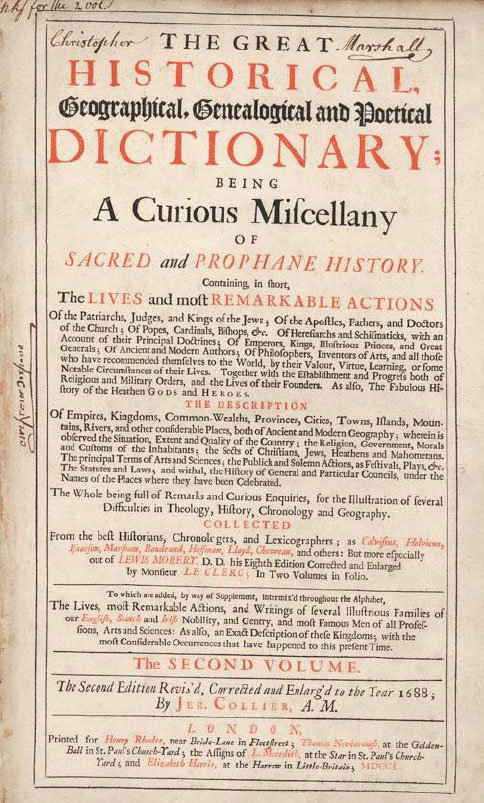- Relief printing
- Intaglio and planographic printing
- Color printing
- Bits and pieces
- Early photography in silver
- Non-silver processes
- Modern photography
- Color notes
- Color photography
- Photography in ink: relief and intaglio printing
- Photography in ink: planographic printing
- Digital processes
- Where do we go from here?
Two-color letterpress

Two-color letterpress. Jeremy Collier. Title page from The Great Historical, Geographical, Genealogical and Poetical Dictionary. 1701. 14 3/4 x 9" (37.5 x 22.9 cm). The Museum of Modern Art, New York. Gift of Richard Benson. When printers began to add color by printing more than once on a single sheet of paper, they encountered the problem of registration—the alignment of the two impressions with each other. In this example, the layout of the type leaves plenty of room for error.
Where the hand-colored and stenciled map combined single-impression printing with hand coloring, this sheet was printed in two colors using a press for both. Two different forms of type were set, the one to be printed in black leaving blank spaces where the red words would go, the one to print red being mostly empty to accommodate the black impression. The sheet was put through the press twice—the black surely printed first—and the hand press was carefully manipulated to impress the red words as accurately as possible in their intended location. Registration on these early presses was crude at best. Our example was laid out so that no part of the print required absolutely accurate registration; the two impressions needed to be fitted to each other within only about a sixteenth-of-an-inch tolerance to be acceptable.
There are two ways to print a picture in more than one color. The simplest method is to ink different parts of the form with different colors. This was sometimes done when there was a large capital letter at the start of a page or section; it was relatively easy to ink that one letter with a bright color, such as red or blue, and then ink the rest of the form with black. When printed the two colors would be in perfect register, since the type was never moved and the sheet was printed only once. Other decorative initials were simply colored in by hand, so they are similar to the hand-colored map. The other way to print in multiple colors is with the method used for this sheet. The practice of putting a piece of paper through the press more than one time has become the basis of all complex color printing. The biggest problem faced in the development of this multiple-impression technique was to achieve accurate registration of the two images. Our example, made by letterpress, was printed on tough rag paper that was dampened before printing. Because the paper was printed wet, it varied slightly in size from one pass to the next, which meant that multiple impressions could never be registered accurately enough to print pictures.

